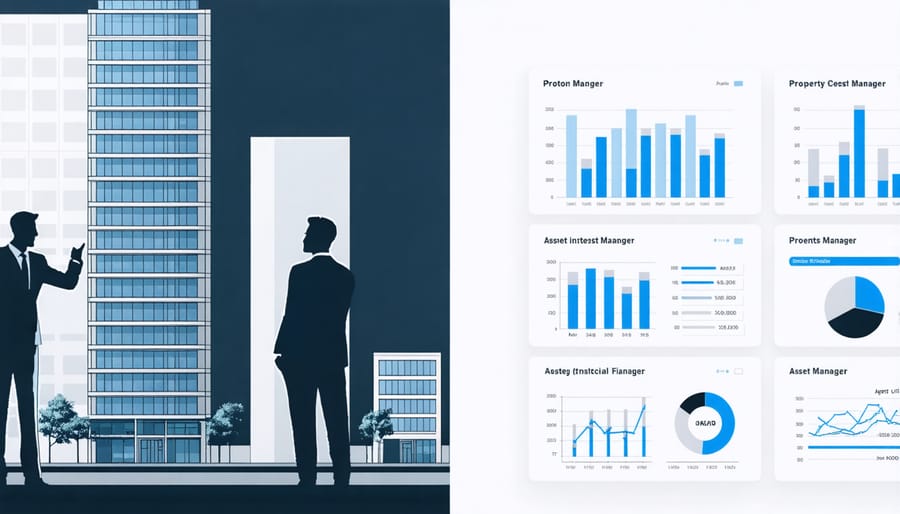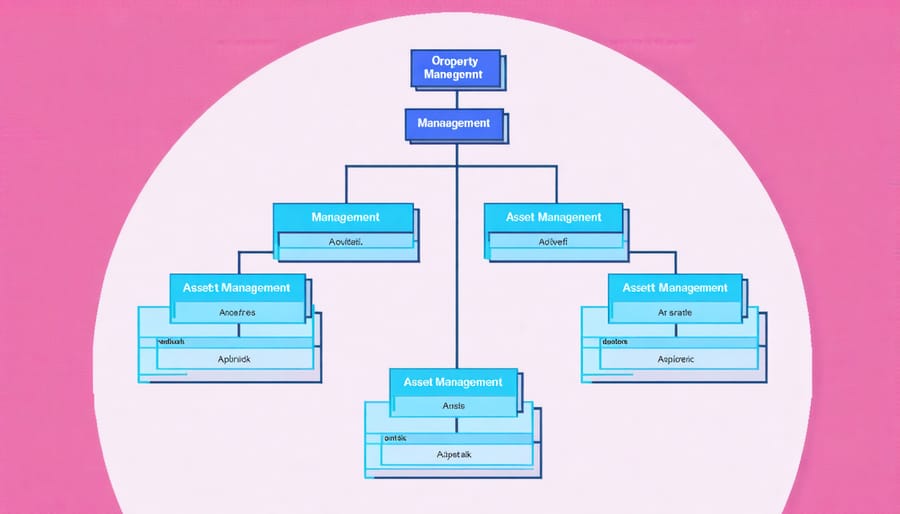Property management and asset management, while often conflated in real estate circles, serve distinctly different yet complementary functions in maximizing real estate investment value. Property management focuses on the day-to-day operational aspects of maintaining physical properties, ensuring tenant satisfaction, and handling immediate concerns. Asset management, conversely, takes a broader strategic approach, focusing on long-term financial performance, portfolio optimization, and investment strategy development. Understanding this fundamental distinction is crucial for real estate investors and professionals seeking to structure their management approach effectively.
Consider a high-rise commercial building: while the property manager ensures the HVAC systems function properly and tenant complaints are addressed promptly, the asset manager analyzes market trends, evaluates potential renovations for ROI, and makes decisions about repositioning the property within the market. This dynamic interplay between tactical operations and strategic planning forms the backbone of successful real estate investment management.
As the real estate industry evolves with technological advances and changing market demands, the distinction between these roles becomes increasingly important for maximizing investment returns and maintaining competitive advantage in today’s complex market landscape.

Core Functions of Property Management
Operational Responsibilities
Property managers focus on day-to-day operational tasks essential for maintaining property value and tenant satisfaction. Their responsibilities typically include routine maintenance scheduling, emergency repairs coordination, and regular property inspections. These duties are often clearly outlined in property management agreements to ensure accountability and service delivery standards.
In contrast, asset managers primarily oversee strategic decisions while delegating operational tasks to property management teams. They establish maintenance budgets, approve major capital improvements, and determine optimal service levels that balance cost efficiency with property value preservation.
Property managers serve as the primary point of contact for tenants, handling lease administration, rent collection, and addressing occupant concerns. They maintain detailed documentation of all maintenance activities, vendor relationships, and tenant communications. This includes coordinating with service providers, conducting regular safety inspections, and ensuring compliance with local building codes and regulations.
The operational scope also encompasses preventive maintenance programs, energy efficiency initiatives, and sustainability measures. Property managers must balance immediate operational needs with long-term property preservation goals, always considering the asset manager’s strategic objectives and budget constraints. This requires expertise in building systems, vendor management, and customer service, along with strong organizational and problem-solving skills.
Financial Management at Property Level
Financial management at the property level involves meticulous oversight of day-to-day monetary operations that directly impact a property’s operational efficiency. Property managers execute advanced property management services by implementing robust systems for rent collection, maintaining detailed financial records, and managing operating expenses.
Rent collection procedures typically include establishing payment schedules, monitoring receivables, handling late payments, and implementing collection protocols when necessary. Property managers must also maintain accurate records of security deposits and ensure compliance with local regulations regarding their handling.
Budgeting responsibilities encompass creating annual operating budgets, forecasting maintenance expenses, and planning for capital improvements. This includes analyzing historical data, market conditions, and anticipated property needs to develop realistic financial projections. Property managers must carefully track actual expenses against budgeted amounts and make necessary adjustments throughout the fiscal year.
Expense management involves overseeing vendor contracts, utility payments, insurance premiums, and maintenance costs. Property managers are responsible for negotiating service contracts, reviewing invoices, and ensuring all expenditures align with approved budgets. They must also maintain detailed documentation for tax purposes and implement cost-saving measures without compromising property quality or tenant satisfaction.
Regular financial reporting to property owners includes monthly income statements, expense reports, and variance analyses, providing transparency and accountability in property operations.
Strategic Role of Asset Management
Investment Strategy and Portfolio Optimization
While property management focuses on day-to-day operations, asset management takes a broader approach to investment strategy and portfolio optimization. Asset managers develop comprehensive strategies to maximize property value and return on investment through careful market analysis, risk assessment, and strategic planning. They continuously evaluate market trends, identify opportunities for value enhancement, and make data-driven decisions about property acquisitions, dispositions, and renovations.
A key aspect of asset management involves portfolio diversification and balance. Asset managers analyze various property types, locations, and market segments to create resilient portfolios that can weather market fluctuations. They implement sophisticated financial modeling techniques to optimize cash flow, reduce operational costs, and enhance property performance across the entire portfolio.
As the future of property management evolves, asset managers increasingly leverage technology and analytics to make informed investment decisions. They utilize advanced data analytics tools to track key performance indicators (KPIs), measure return on investment (ROI), and identify areas for improvement across the portfolio.
This strategic approach extends to capital improvement planning, where asset managers evaluate and prioritize renovation projects based on their potential impact on property value and market positioning. They also maintain strong relationships with investors, providing regular performance reports and adjusting strategies to meet investment objectives while maintaining alignment with market conditions.
Financial Analysis and Risk Management
In the realm of real estate investment, financial analysis and risk management represent critical differentiators between property and asset management roles. Asset managers focus on comprehensive market analysis, evaluating broader economic trends, and making strategic investment decisions that optimize portfolio performance. They conduct detailed financial modeling, assess market cycles, and determine optimal holding periods for properties while considering factors like sustainability and ROI.
Property managers, while also involved in financial matters, concentrate on operational-level financial analysis. Their risk management responsibilities typically revolve around maintaining property value, ensuring steady cash flow, and managing day-to-day financial risks such as tenant defaults or unexpected maintenance costs.
Asset managers must consider portfolio-wide risk factors, including market volatility, interest rate fluctuations, and demographic shifts that could impact multiple properties simultaneously. They develop sophisticated risk mitigation strategies, often incorporating diversification across property types and geographic locations.
The financial responsibilities of both roles intersect when it comes to budgeting and performance reporting, but asset managers take a more strategic approach, focusing on long-term value creation and portfolio optimization. They analyze potential acquisitions, dispositions, and repositioning opportunities while considering broader market conditions and investment objectives. Property managers, in contrast, focus on implementing these strategies through effective cost control and revenue optimization at the property level.

Key Differences and Synergies
Scope and Focus
Property management and asset management operate on distinctly different levels within real estate operations, each serving crucial yet separate functions. Property management primarily focuses on day-to-day operational responsibilities, including tenant relations, maintenance coordination, and immediate problem resolution. These tasks ensure the property maintains its current value and operational efficiency through hands-on supervision and implementation of routine procedures.
In contrast, asset management takes a broader, more strategic approach. Asset managers develop long-term investment strategies, analyze market trends, and make decisions about property acquisitions, dispositions, and major capital improvements. They focus on maximizing the property’s financial performance and overall return on investment through strategic planning and portfolio optimization.
While property managers ensure buildings run smoothly on a tactical level, asset managers evaluate performance metrics, analyze market conditions, and make strategic decisions that affect the property’s long-term value proposition. Property managers might handle lease negotiations and maintenance schedules, while asset managers determine optimal tenant mix strategies and approve major renovation projects to enhance property value.
The scope of responsibilities creates a hierarchical relationship where property management typically reports to asset management, ensuring that day-to-day operations align with broader strategic objectives. This structured approach enables organizations to maintain operational excellence while pursuing long-term value creation and portfolio growth.
Decision-Making Authority
Property managers and asset managers operate with distinct levels of decision-making authority, reflecting their different roles and responsibilities in real estate management. Property managers typically handle day-to-day operational decisions within predetermined budgets and guidelines. Their authority extends to routine maintenance scheduling, tenant relations, vendor selection for basic services, and implementing established policies.
Asset managers, conversely, wield broader strategic decision-making power that directly impacts the property’s long-term value and financial performance. They have the authority to make high-level decisions about capital improvements, refinancing, major renovations, and property repositioning. This includes setting rental rates, approving significant expenditures, and determining optimal timing for property acquisition or disposition.
The decision-making hierarchy typically flows from asset managers to property managers. While property managers can recommend major changes or improvements, the final approval usually rests with asset managers who must align these decisions with broader investment objectives. Asset managers also have the authority to establish property management policies, set performance metrics, and modify management strategies based on market conditions.
This authority structure ensures efficient property operations while maintaining strategic oversight. Property managers focus on executing approved plans and maintaining daily operations, while asset managers concentrate on investment strategy and portfolio-level decisions that maximize return on investment.
Collaborative Framework
Property management and asset management operate in a symbiotic relationship, where each role’s effectiveness directly impacts the other’s success. The collaborative framework between these functions creates a comprehensive approach to real estate portfolio optimization, maximizing both operational efficiency and financial returns.
Asset managers typically establish the strategic vision and investment objectives, while property managers implement these strategies through day-to-day operations. This collaboration begins with regular communication channels, including quarterly performance reviews, monthly operational reports, and real-time updates on critical issues. Asset managers rely on property managers’ ground-level insights to make informed decisions about capital improvements, repositioning strategies, and market opportunities.
The synergy becomes particularly evident in budget planning and execution. Property managers provide detailed operational data and market intelligence, which asset managers use to develop financial models and investment strategies. This information exchange ensures that capital allocation decisions align with both immediate property needs and long-term portfolio objectives.
Success in this collaborative framework depends on clear delineation of responsibilities and established protocols for decision-making. For instance, while property managers handle routine maintenance decisions independently, they consult with asset managers on significant capital expenditures or strategic improvements that could impact the property’s market position or value.
Regular joint assessments of property performance, market conditions, and tenant satisfaction help both teams adjust strategies and maintain alignment with overall investment goals. This integrated approach ensures that operational excellence translates into optimal financial performance and portfolio value appreciation.

Industry Case Study
The One World Trade Center in New York City presents a compelling example of successful integration between property and asset management. Following its completion in 2014, the 1,776-foot skyscraper required a sophisticated management approach to maximize its $3.8 billion investment while maintaining world-class operational standards.
The property management team, led by The Durst Organization, focused on day-to-day operations, including security protocols, maintenance schedules, and tenant relations. They implemented a state-of-the-art building management system to monitor energy consumption and maintain optimal environmental conditions, resulting in LEED Gold certification and annual operational cost savings of approximately $2.5 million.
Simultaneously, the asset management team, working with the Port Authority of New York and New Jersey, developed strategic initiatives to enhance the property’s value. They structured a dynamic leasing strategy that attracted premium tenants like Condé Nast and GroupM, achieving 95% occupancy within five years. The team also negotiated strategic partnerships for the observation deck, which generates an additional $25 million in annual revenue.
This collaborative approach demonstrated how property and asset management can work in tandem. While property managers ensured the building’s prestigious status through impeccable maintenance and tenant satisfaction, asset managers focused on financial performance through strategic leasing, capital improvements, and revenue diversification. The result was a 15% increase in property value over five years, exceeding market expectations and establishing One World Trade Center as both a symbolic landmark and a profitable commercial asset.
The distinction between property management and asset management continues to evolve as the real estate industry becomes increasingly sophisticated. While property managers focus on day-to-day operations and tenant satisfaction, asset managers drive long-term value creation through strategic portfolio optimization. Understanding these complementary roles is crucial for organizations seeking to maximize their real estate investments.
Looking ahead, technology integration and data analytics will further transform both disciplines. Property managers will leverage smart building solutions and automated maintenance systems, while asset managers will utilize advanced portfolio analysis tools and predictive modeling for improved decision-making. The growing emphasis on sustainability and ESG considerations will also reshape both roles, requiring new expertise and approaches.
Success in today’s competitive market demands a seamless collaboration between property and asset management functions. Organizations that effectively integrate these disciplines, while maintaining their distinct focuses, will be better positioned to achieve both operational excellence and strategic growth. As the industry continues to mature, professionals in both fields must remain adaptable, embrace technological advancement, and maintain a clear understanding of their unique contributions to the overall real estate value chain.

